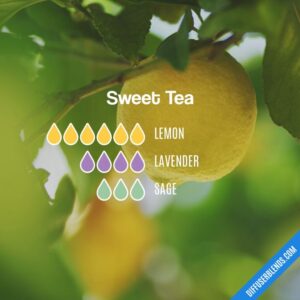The next challenge on my list is a pretty 56 kilometer walk from Amalfi to Naples via Positano, Pompeii and Vesuvius. The street views present a coastal drive with dramatic views of the crystal-blue Mediterranean sea, local fishing villages, and iconic terraced lemon groves. No wonder it’s among the most famous stretches of the Italian coastline. The Amalfi coast is famed for its production of Limoncello liqueur and the area is a known cultivator of lemons. The correct name is “sfusato amalfitano”, and they are typically long and at least double the size of other lemons, with a thick and wrinkled skin and a sweet and juicy flesh without many pips. It is common to see lemons growing in the terraced gardens along the entire Amalfi coast between February and October.
I’m going to share with you assorted on a lemon theme. Because. Just because, all right? I am pretty sure I promised that this blog would be inconsistent as all get out. I am delivering on that promise. You should be happy about it.
The Traveling Lemon
I was introduced to the joys of the Traveling Lemon as a result of a radio show called Cabin Pressure. The objective of The Travelling Lemon is to hide a lemon in plain sight among the passengers on a flight, so that another player can find it and hide it again. The lemon may be replaced by other citrus fruit if it is mutually agreed to by the players before the game begins.
Introduce this game to your kids or partner. Seriously, just having a lemon that drifts around your apartment, condo, or house over a month is a constant reason to smile. Just remember to use the current lemon once a week if you do so. That’s what Sharpies were invented for. Write the date on the lemon when you start, so it doesn’t go bad before you get tired of the game.
You can hear season 3 episode 1 (Qikiqtarjuarq) below. I shouldn’t be the only person who adores this show. It follows a small English airline trying to make a go of it. Canadian director of nature trip company Unbeaten Track is disappointed with Douglas’s attitude and tells him he is unprofessional and that Martin is professional. Douglas is infuriated by this and gets his own back on Martin by humiliating him with the cabin intercom. Meanwhile in the cabin, Arthur teaches the passengers all about bears and gets rather excited. Carolyn is in need of some “light entertainment” and she and Douglas enjoy a game of The Travelling Lemon which just results in more humiliation for Martin.
🍋 🍋 🍋 🍋 🍋
The lemon is in play. If, by some chance, you have fallen in love with Cabin Pressure, ping me and I can help you get all the episodes.
🍋 🍋 🍋 🍋 🍋
Diffuser recipes featuring Lemons
Arbitrary topic change. Here are a selection of diffuser recipes featuring lemon essential oil. Because. Stop asking questions.
Lemon Facts
- Lemons are native to Asia.
- Lemons are a hybrid between a sour orange and a citron.
- Lemons are rich in vitamin C.
- Lemons trees can produce up to 600 pounds of lemons every year.
- Lemon trees produce fruit all year round.
- Lemon zest, grated rinds, is often used in baking.
- Lemon tree leaves can be used to make tea.
- The high acidity of lemons make them good cleaning aids.
- California and Arizona produces most of the United States’ lemon crop.
- The most common types of lemons are the Meyer, Eureka, and Lisbon lemons.
- Lemons are technically berries.
- The average lemon contains 8 seeds.
- Sprinkling lemon juice on other fruits can keep them from turning brown.
- Lemons used to be so rare that kings would present them to other kings as gifts.
- Attaching lemons using electrodes produces electricity.
- Christopher Columbus brought lemon seeds with him to the Americas in 1493.
- Lemons are considered to be anionic. This means that they have more electrons (negatively charged ions) of energy as compared to cations (positively charged ions) in their atomic structure.
Postcards
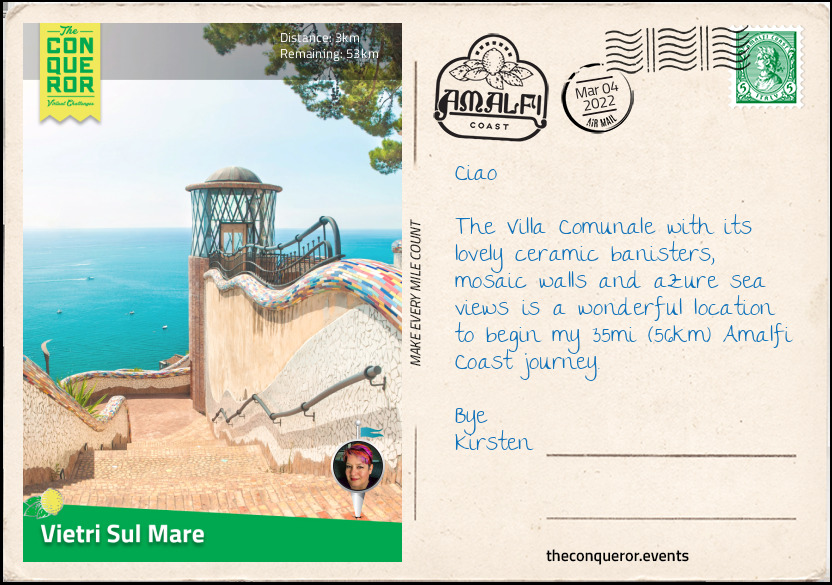
Beginning in the small fishing village of Vietri Sul Mare is the gateway to the Amalfi Coast, a coastal journey along the Tyrrhenian Sea, through small cliff top villages, famous towns like Positano, past vineyards, villas and lemon groves.
Amalfi Coast isn’t particularly long but it is full of surprises. Listed as a UNESCO site since 1997, Amalfi Coast is known for its limoncello liqueur, painted tiles, the elegant Amalfi paper, the Emerald Grotto, the semi-sweet Amalfi lemon and of course its dramatic views along a winding route.
Whilst traditionally the Amalfi Coast begins in Vietri Sul Mare and ends in Positano, my journey will go beyond Positano, across the Sorrentine Peninsula and into the town of Sorrento. At 35mi (56km) long, I look forward to endless sea views, small beaches and Italian cuisine.
I began my travels at the Villa Comunale, a public square perched up on the edge of a sheer cliff face with expansive views across the Gulf of Salerno. Constructed entirely out of ceramic tiles, this terraced square is a kaleidoscope of colour and mosaic tiling and pays homage to Vietri’s long history of ceramics and pottery production in the region.
Vietri’s ceramic tiles date back to Roman times, when exactly is unknown though. There are some records that indicate trade in the late 9th century of vases and tableware but more detailed recorded history begins around the 14th century. The quality and craftsmanship of Vietri tiles took a leap in the 17th century and by the 20th century with the arrival of renowned artists and craftsmen, mostly from Germany, took Vietri’s ceramic tiles internationally. The Germans were also skilled chemists and through their experiments many unique colours were invented with “Vietri yellow” being amongst them.
Vietri showcases its ceramic tiles throughout the village from the cupola of Parish Church of St John the Baptist, built in 1732; to the various laneways and buildings that are decorated with the tiles; and along Corso Umberto where shops specialising in ceramic wares line the street including Cassetta Ceramica, the oldest family of ceramists who began production in the early 16th century.
Just to the north of Villa Comunale is the Solimene Artistic Ceramics factory, an impressive custom made building for the founder of the company, dating 1954, that continues to produce handmade ceramics combining old traditions with new technologies.
Italian cuisine is known for its simplicity, using few ingredients that are fresh and flavoursome. Being in a fishing village I chose a seafood risotto. Made from arborio rice, it is gently cooked in broth with tomato puree added before the rice is fully cooked. A seafood combination of clams, mussels and shrimp tossed in olive oil with garlic and mild chilli is added on top and garnished with fresh parsley.
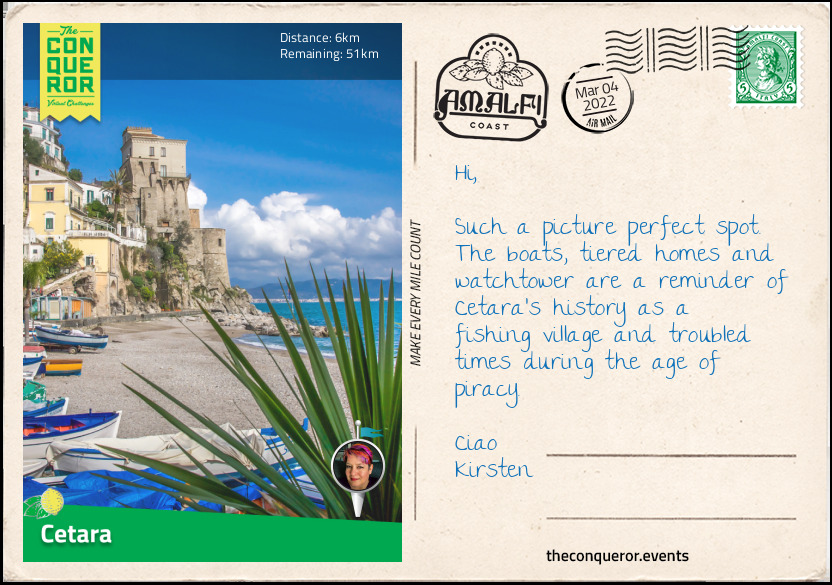
Cetara is a small and unassuming coastal village removed from the hustle and bustle of the more famous towns on the Amalfi Coast route. It would be easy to breeze through Cetara in search for more dynamic and lively locations if it wasn’t for one famed delicacy.
Cetara has a thriving seafood industry particularly red tuna and as such is not quite as dependent on tourism leaving this village largely untouched by overdevelopment, and open to authentic cultural experiences and local foods.
The village was originally settled by Arabian pirates around 880AD and later conquered by the Normans. When it was attacked by Turks in the mid-16th century, the village built the Tower of Cetara, to defend its coastline. Most of the village was eventually abandoned until the few residents that remained joined the municipality with Vietri until 1833 when it gained its independence.
Now you might be wondering what that famed delicacy was. It came in the form of the small bluefish that many of us find too strong in flavour and extremely salty – the anchovy. Since Roman times, Cetara has been perfecting a special anchovy sauce known as Colatura di Alici (anchovy drippings). The sauce contains only two ingredients: anchovies and salt. Taking a wooden barrel the anchovy fillets are layered with salt, sealed and left to ferment for several years. During this fermentation process the anchovies release liquid which becomes the sauce. When the process is complete a hole is made at the bottom of the barrel and the sauce drains through the anchovies and then bottled. The final sauce is a transparent, amber-coloured liquid that is sparingly used on various dishes including pasta and pizza. As you might imagine this lengthy process creates a product that is both a specialty and expensive. Using it sparingly would make for a wise decision and long lasting bottle.
With that in mind and always willing to explore new flavours, I went in search of a Spaghetti con la Colatura di Alici in one of the local restaurants. In its simplest form this pasta dish is reminiscent of the well-known Aglio e Olio Pasta (garlic and oil pasta) except that it is flavoured with colatura. Savouring each forkful of twirled spaghetti coated in olive oil, I enjoyed the hints of garlic and pepper flakes, the subtle saltiness of the anchovy sauce, the acidity of the lemon zest and the lightly toasted breadcrumbs for a little texture.
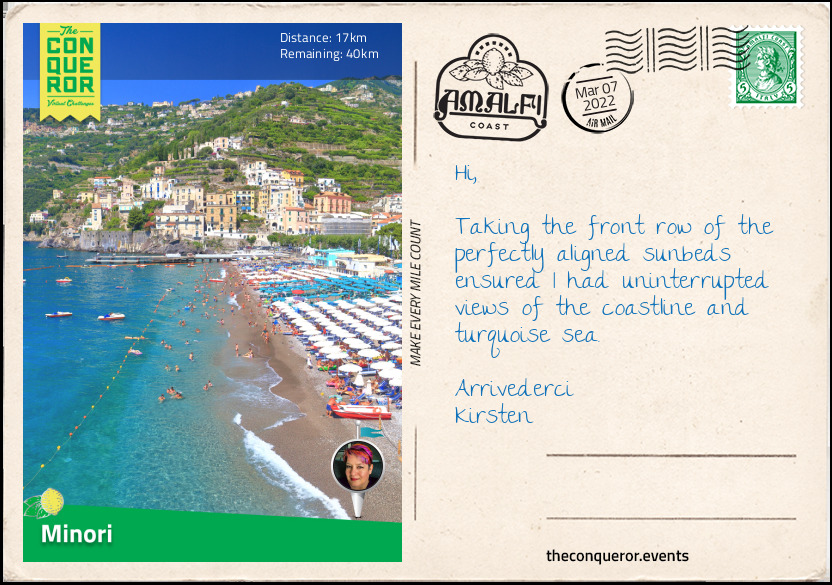 Separated by half a mile (800m) from each other are the towns of Maiori and Minori. Both tucked in valleys and known for their beautiful azure beaches, they are separated by a promontory. Atop the promontory is the small village of Torre which is full of terraced vineyards, lemon groves and olive trees.
Separated by half a mile (800m) from each other are the towns of Maiori and Minori. Both tucked in valleys and known for their beautiful azure beaches, they are separated by a promontory. Atop the promontory is the small village of Torre which is full of terraced vineyards, lemon groves and olive trees.
Maiori was at the epicentre of a major flooding event in 1954 when its main street, Corso Regina, that was built on top of a flood-prone stream collapsed, taking many buildings with it. The reconstructed buildings carry many of the late 20th century influences.
The mouth of the stream is in the middle of the longest stretch of beach on the Amalfi Coast and a promenade runs along the whole length of the beach. To the east of the town is the 13th century Norman Tower built on rocky outcrops that once served as a watchtower protecting the coast.
To the west of the town on a hilltop is the 13thC Collegiate Church of Santa Maria e Mare. Its main treasure is the collection held in the Sacred Art Museum located within the Church’s crypt exhibiting religious artifacts such as statues and busts of saints, crosses, chalices and silver artifacts to name a few.
Exploring the Path of the Lemon trail in the village of Torre I am introduced to the special Amalfi Lemon. Cultivated in terraced gardens all along the Amalfi Coast, the lemon is described as: long, tapered and double the size compared to other lemons with thick, wrinkled skin, intense perfume and sweet, juicy flesh. What gives these lemons their special properties is the Mediterranean climate, protection from the cold northern wind by the mountains and exposure to the sea breeze and strong sun, much like the Menton Lemons found on the French Riviera. Used extensively in cooking very little of the lemon is wasted: juice to flavour; leaves for aroma; or wedges dressed in salt, oil and mint as an appetizer.
Skirting around the terraced promontory, I arrive in Minori and its small rectangular beach tucked in a cove. One of the main attractions in town is the remains of a 1stC villa that was used as a holiday getaway by the Roman aristocracy. Partial remains were discovered by accident in 1932 when some local homes collapsed during renovation and the Roman chambers were exposed. Further remains were unearthed after the 1954 flooding and again in 1956 when St Lucia Hotel was built.
Minori may be small but it’s famous for the Pear and Ricotta Cake created by pastry chef Sal De Riso. Made of thin hazelnut sponge, the filling is a combination of ricotta and whipped cream mixed with cubes of pears cooked in syrup. The locally grown ingredients, pears from Agerola and ricotta from Giffoni, both within a short distance of Minori, makes this cake a specialty and a symbol of the Amalfi Coast.
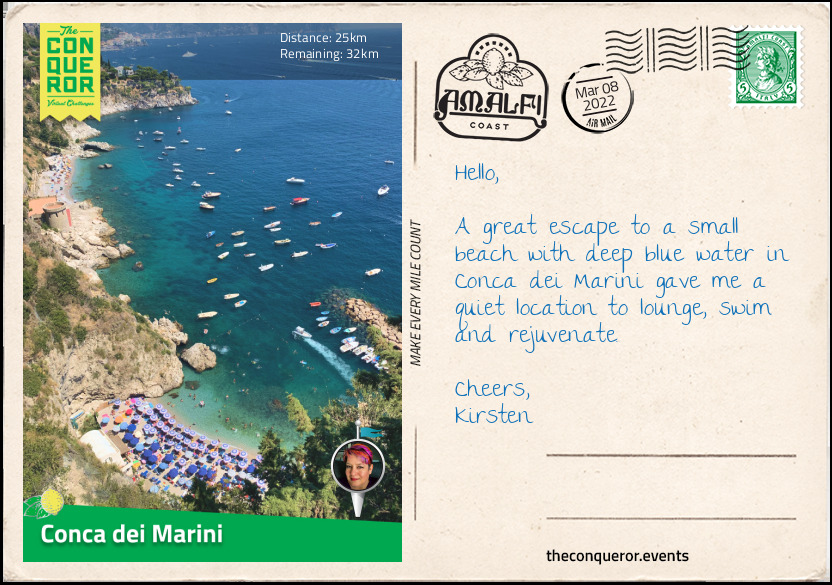
Conca dei Marini is a small town of less than 700 people. It is mostly known for two things: the Emerald Grotto and the Santa Rosa dessert known as Sfogliatella.
The grotto is a partially inundated cave measuring approximately 147ft (45m) long, 105ft (32m) wide and 79ft (24m) high above water level. It’s unique emerald colour is due to an underwater fissure that filters light through. Inside the cave are columns of stalactites and stalagmites of varying shapes and some as high as 33ft (10m). The grotto was discovered by accident in 1932 by a local fisherman.
To the east of the grotto atop a promontory is the Cape of Conca Tower. Built in the 16th century, as a watchtower, it carried the same purpose as the one in Cetara and Minori, defending the territory from the Turks. Once it lost its importance, the tower was used as a cemetery until 1949 when the local government restored it and turned it into a museum. Reaching the tower required a downhill hike on a well paved road, followed by a steep uphill climb via stairs but the effort was rewarded with spectacular panoramic views of the coast, the sea and the houses perched on the hills.
Located high up on a hill is the 17th century Santa Rosa Monastery where a nun wanting to use up leftovers created an entirely delicious pastry dessert called Sfogliatella Santarosa. Using leftover bread dough she added white wine and lard and kneaded it into a puff pastry. The nun then combined her leftover semolina cooked in milk with lemon liqueur, dried fruit and sugar turning it into a custard. Adding the custard to the puff pastry it was then baked in a wood oven. The dessert was such a success that its recipe was guarded for the next 150 years until a pastry chef from Naples acquired it, reproduced it and began selling it in the early 1800s. The pastry dough and filling has varied since but it remains a well-loved dessert, so much so that it has its own annual festival in town in August.
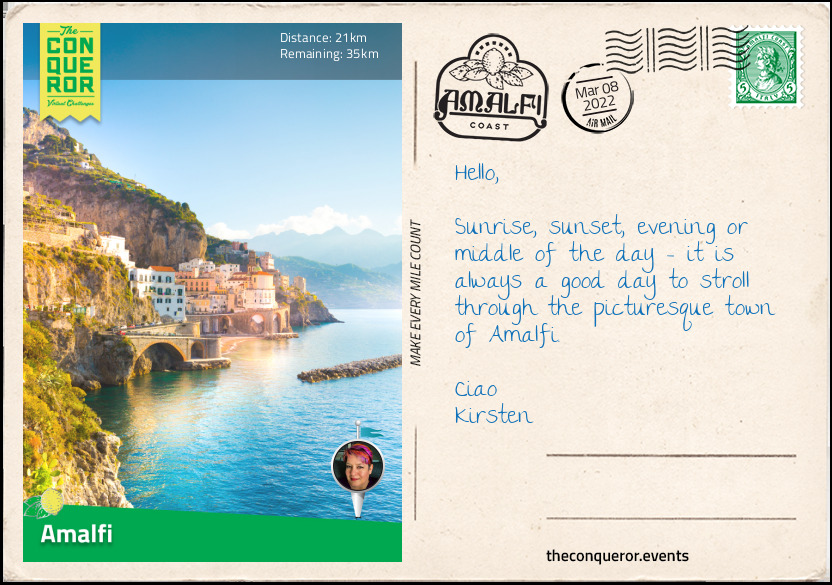
Amalfi is a popular tourist destination located at the foot of Monte Cerreto. It was an important town between the 9th and 11th centuries when Amalfi was the capital of the maritime republic and an important maritime trading port. From the 1920s-30s it was a holiday destination for the wealthy and aristocratic Brits. Now it is the main coastal town on the Amalfi Coast route and known for its Byzantine cathedral and specialty Amalfi paper.
The cathedral was built in the 10th century and is dedicated to Apostle St Andrew whose relics are kept in the cathedral’s crypt. Redecorated many times in various architectural styles, the cathedral’s façade collapsed in 1861 requiring a full reconstruction of the church’s front. It was during this rebuild that the church received its current façade with its richly decorated, intricately patterned design showcasing Arab-Norman and Italian Gothic styles. Completed in 1891, the church is accessed via a wide and steep staircase, totalling 62 steps. The interior has a central nave and two aisles that are separated by 20 arches. Two rows of chandeliers hang above the pews, each one aligning with an archway softening the rich and contrasting colours of the interior.
North of the Piazza is the Amalfi Paper Museum showcasing the origins of this specialty paper. Also known as Carta Bambagina, this thick, soft, exquisite paper that is primarily used for special events and hand-sewn books was once a cheaper form of paper than parchment.
Its roots are traced back to its trade with the Arab world when the first paper invented in China (c106AD) had made its way into the middle-east. Through commercial relations the paper crossed the Mediterranean and by the 12th century Amalfi became one of the first locations to begin production of such paper in Western Europe.
The paper was made from cotton rags by beating it to a pulp, then spreading a thin layer of the pulp over a thin wire mesh and placing it inside a vat of water. When the pulp was removed, the water was drained and pressed between two pads to remove the excess water. The final stage was to hang the sheet out to dry. The production of paper took a hold over the following centuries and reached its pinnacle in the 18th century when as many as 14 paper mills existed in Amalfi. Due to new technologies, a shift towards wood and vegetable pulps for raw materials and ability to mass produce, sent the production of paper from cloth into decline. The final blow to Amalfi was the 1954 flood that destroyed most of the paper mills. Today only one paper mill remains.
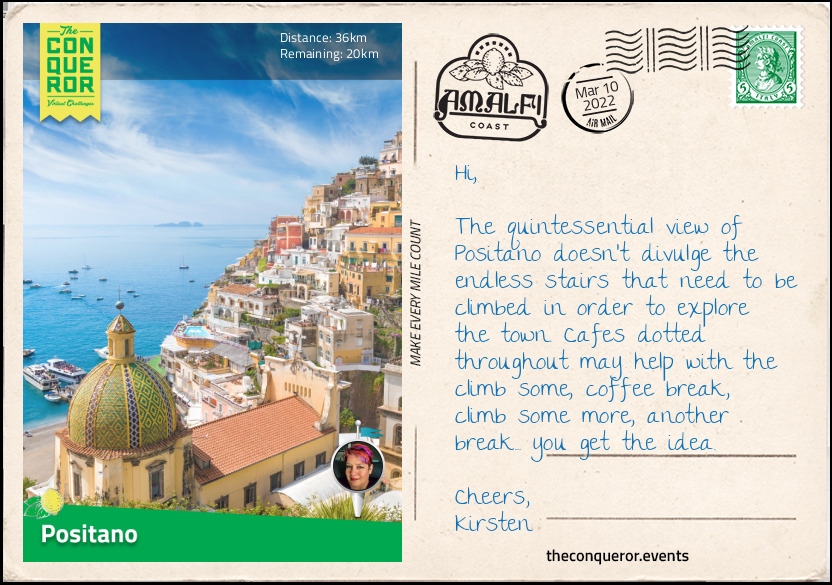
Perched up in the hills overlooking the sea is the very popular town of Positano. The pastel coloured buildings spilling down the hills give the impression of a dusty rose ombre layered cake. Yet the narrow roads through and around the town with their curves and sharp turns are reminiscent of a Grand Prix Formula 1 track. And then, there’s all the stairs tucked amongst the buildings leading up or down through narrow alleyways.
There are two main beaches in Positano. Each one has a private and public section. The private section is defined by rows of neatly lined lounge chairs, each one with their own umbrella and a fee to hire. Whereas the public section is freely accessible without lounges or any service.
Positano thrived and declined many times throughout history. It endured destruction from a tsunami in 13thC; attacks from the Ottomans in 15thC; gained wealth through maritime trading in 18thC; and had its final decline in 19thC following Italy’s unification and opening of other commercial routes. As a result, many emigrated to the United States and Positano was reduced to a small fishing village.
However, in mid-20thC it was launched onto the world stage when John Steinbeck, an American author, drove from Rome to Positano to escape the summer heat. He was so enchanted by the location that he wrote a lengthy essay about the town and had it published in Harper’s Bazaar in 1953. So began Positano’s economic turnaround.
At the heart of the town is Chiesa di Santa Maria Asunta, a 13thC church with a majolica-tiled dome. Tucked away amongst narrow streets it is accessible by two sets of stairs and known for its Byzantine Black Madonna and Child icon. According to legend the icon was once carried by a pirate ship sailing in the nearby waters of Positano. When a furious storm hit, with little chance of survival, the pirates heard the cries of Mary from the icon say “lay me down”. Taking that as a sign the pirates turned the bow towards land and miraculously arrived safely in harbour. Once ashore they handed the icon to the local people who then built the church in her honour.
Now let’s talk about food. The Campania region encompasses the Amalfi Coast and it is the birthplace of Campania’s Buffalo Mozzarella, a cheese made from indigenous buffalo’s milk. The curd, cut by hand, is made into small balls with a creamy texture and tangy sweet flavour. The most delightful way to enjoy the flavour of this particular cheese is in a Caprese Salad.
On a dinner plate layer sliced vine-ripened tomatoes, with sliced buffalo mozzarella, topped with fresh basil leaves. Drizzle extra-virgin olive oil and aged-balsamic vinegar, and season with salt and pepper. Buon appetito!!
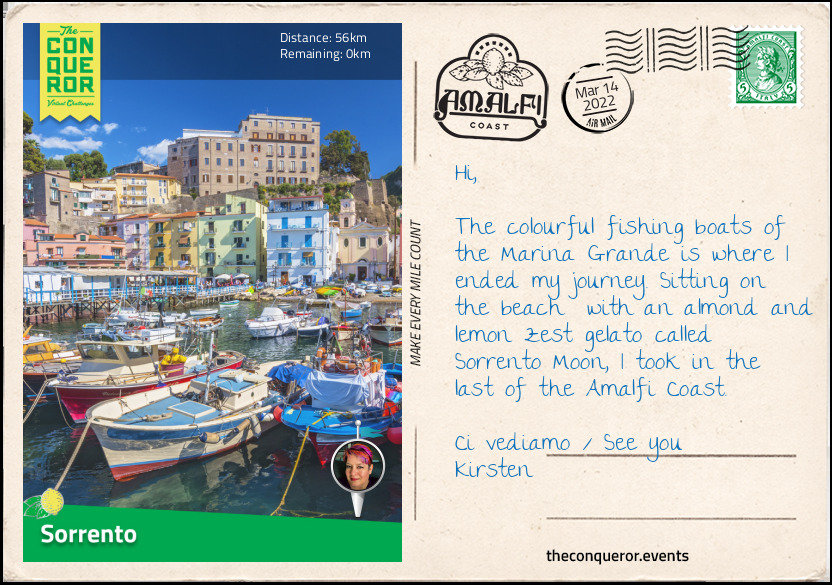
Cutting across the Sorrentine Peninsula, I arrive in Sorrento, my final destination. Overlooking the Bay of Naples, Sorrento is a laid back town that is known for its marquetry, Sorrento lemons and Limoncello.
Housed in an 18thC building is the Inlaid Wood Museum that showcases Sorrento’s long history of marquetry furniture. Thin sheets of wood, cut into intricate patterns were adhered to furniture creating decorative pieces for the home. The museum’s collection covers periods from 1400-1800AD exhibiting various furniture pieces and explaining the techniques and tools used by the artists. Around 700 skilled artisans continue this tradition blending historical techniques with modern processes.
Sorrento lemons are a variety that are PGI (Protected Geographical Indication) certified. Described as medium to large, oval-shaped citrus fruit with a thick skin, very juicy pulp and almost seedless, what makes it unique is its peel that is rich in essential oils making it highly fragrant. The lemons are grown on tall wooden frames (as high as 15ft/5m) in order to protect them from the elements and allow the fruits to ripen slowly. Historically it was only handled by women, with trimmed nails wearing cotton gloves to protect the fragile rind from damage and subsequent fungal rot. The Sorrento lemons as with the Amalfi lemons are a staple fruit on any Italian table.
The Sorrento lemon is also used for producing the somewhat sweet liqueur known as Limoncello. At least 60% of the Sorrento lemons grown are reserved for the production of the liqueur. Used as an aperitif or a digestif, Limoncello is typically served chilled without ice and sipped slowly. It is made from lemon zest, water, alcohol and sugar. Because the zest is the main component of the liqueur the lemons are usually hand-picked in order to prevent it from contacting the ground and bruising the peel.
Continuing with this versatile citrus fruit, a great way to finish a wonderful journey along the Amalfi Coast is with a Pasta al Limone (aka Pasta in lemon sauce – it sounds so much better in Italian). Cooked pasta is added to a sauce of butter, garlic and lemon zest and tossed till it’s coated, then grated parmesan cheese mixed through to thicken the sauce. Lemon juice is added to taste and seasoned with salt and pepper then garnished with more grated parmesan and lemon zest.
Arrivederci / Until we meet again.


